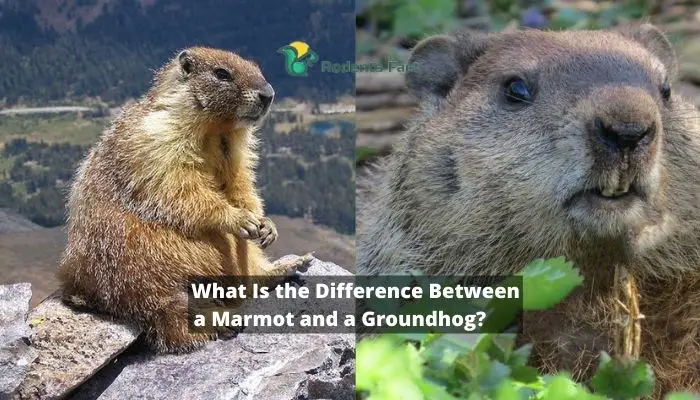What Is the Difference Between a Marmot and a Groundhog? 5 Identical Differences
Marmots and groundhogs are both members of the rodent family, but they are not the same animal. It’s too much identical to tell the differences. So, what is the difference between a marmot and a groundhog?
There are many differences between marmots and groundhogs, but the most notable difference is their size. Marmots are much larger than groundhogs, weighing up to twice as much. They also have longer fur, and their tails are bushier. Groundhogs, on the other hand, have shorter fur and tails.

Marmots are also more likely to be found in the wild, while groundhogs are more likely in urban areas. Marmots are found in mountains and rocky areas, while groundhogs are found in fields and woodlands. Marmots hibernate for much longer than groundhogs.
Are marmots groundhogs?
Marmots are not groundhogs. However, marmots and groundhogs belong to the same family of rodents—the marmots or ground squirrels.
This means the groundhogs can be considered marmots but the marmots are NOT groundhogs.
The two animals may look similar, but they have many key differences that exist between them.
For instance, they’re found in completely different places in their natural habitat in North America. Moreover, marmots are available in a wide range of species while there’s only one groundhog species.

Marmots are also usually larger than groundhogs and weigh twice as much as groundhogs. The fur in marmots is usually longer than that of groundhogs.
The marmot tail also appears bushier while groundhogs’ tails are shorter and less bushy.
Groundhogs are also more likely to be found in urban areas while marmots are more common in the wild.
As for the wild habitat, the groundhogs live in woodlands and grasslands while marmots live in rocky and mountain areas.
How to identify if it is a marmot or groundhog?
Here’s a quick marmot vs groundhog comparison table to help you easily identify each of them:
| Marmots | Groundhogs | |
|---|---|---|
| Size | 20 to 26 inches | 16 to 20 inches |
| Weight | 3.5 to 11 lbs. | 3 to 9 lbs. |
| Color | Reddish or brownish | Brownish-yellow or brownish-gray |
| Diet | Herbivore | Herbivore |
| Habitat | Rocky and mountain regions | Woodlands and grasslands |
The easiest way to tell a marmot from a groundhog is the size. Marmots are giant than groundhogs in terms of size and weight. Marmots are also less colorful than their groundhog cousins.

Here are the key differences that help identify a marmot or groundhog:
Size
Groundhogs usually grow up to 20 inches in length and have a tail of 6 to 7 inches. Marmots usually grow bigger than groundhogs and can reach anywhere from 20 to 26 inches. This means their size is comparable to that of an average adult house cat.
Color
The marmot is usually recognized by its yellow belly, thanks to its distinctive yellow far covering its belly as well as the chest area. On top of this, it features grey or brown fur on its back, tail, and head, save for a few individuals featuring white marks on their heads.
Groundhogs may feature a wide range of colors, but their coloration is usually uniform around their body. Common colors for their bodies can vary from cinnamon-brown to grey-brown.
However, their snouts may exhibit color variations, though it depends on the individual.
Marmot Vs Groundhog: What Is the Difference Between a Marmot and a Groundhog?
The two most significant differences between groundhogs and marmots are that the groundhogs are somewhat more giant and less colorful. Furthermore, while groundhogs are more common, yellow-bellied marmots are found in the Western United States. Unlike marmots, groundhogs are less sociable and will burrow in a broader range of habitats.

Let’s delve further into these peculiarities to learn more about them.
Color
A yellow-bellied marmot may be recognized most easily by, well, its yellow belly. They have distinctive yellow fur on their tummy and chest. They have brown or grey fur on their backs, heads, and tails, except for specific individuals with white marks on their foreheads.
While groundhogs have a more comprehensive range of possible colors, their coloration is often more uniform across their bodies.
Their whole bodies can vary in color from grey-brown to cinnamon-brown. Only their snouts frequently exhibit color variations. However, this mainly varies on the individual.
Additional Read: Can Hamsters Eat Guinea Pig Food? | Learn Important Facts
Size

Groundhogs and yellow-bellied marmots are just slightly smaller than each other. They typically weigh between 3 and 9 lbs. and only reach a maximum length of 27 inches.
Not only are groundhogs giant rodents, but they are also among the world’s largest marmot species.
They may grow up to 20 inches long and weigh anything from 6 to 12 pounds, with some much bigger. Although they can live closer to 15 years in captivity, groundhogs typically have a lifetime of 3 to 5 years and achieve sexual maturity between the ages of 1 and 2 years in the wild.
Burrows
Burrows are a feature shared by all ground squirrels, although marmots may own them. Yellow-bellied marmots inhabit stony terrain that frequently contains large rocks.
They frequently build their dens and burrows behind these big stones as an adaption, enabling them to flee from predators without worrying about getting dug out. They are also known to hide among rock heaps to avoid predators.
Burrows is also built by groundhogs, but they are less particular than yellow-bellied marmots. They often dig burrows in well-drained soil and close to forest boundaries. Multiple chambers in a burrow, including ones intended for nurseries, baths, and other uses, are possible.
Habit
All types of marmots are highly clever and gregarious creatures. Yellow-bellied marmots have intricate social structures and can gather in groups of up to 20 people. These colonies even include a whistling communication system and various male/female partnerships.
Even though they are the most reclusive of all the marmot species, groundhogs are nevertheless gregarious animals. The young from the most recent litter and a breeding couple make up the majority of family units. Compared to most groundhogs, yellow-bellied marmots are more sociable.
Being Pet
Although yellow-bellied marmots are occasionally seen as pests, their relative isolation means they aren’t a significant problem for farmers or construction workers.
However, groundhogs are infamous pests.
They frequently dig burrows close to farms and gardens and don’t mind consuming large quantities of produce. Furthermore, their burrows can result in structural damage to buildings and highways.
Is a Groundhog the Same as a Woodchuck?
The two creatures, groundhogs and woodchucks, are the same. Regarding the Sciuridae family of rodents known as groundhogs, they are interchangeable.

Chuck, Woodstock, Whistler, Whistling Pig, Canada Marmot, Red Monk, and Thick Wood Badger are some of their other names. Baby groundhogs are called chucklings.
Are Groundhogs and Marmots Considered Pests?
Few marmot species are as pervasive and destructive as groundhogs, yet many are still considered pests. Yellow-bellied marmots rarely cause damage to human farms or buildings because of their remote habitat.
However, groundhogs are known to inflict structural damage to buildings throughout most of the eastern US and will munch through substantial amounts of crops.
A groundhog will whistle to warn others when it gets startled by a predator. This is how the whistling pig earned its moniker.

Marmots and woodchucks are highly clever creatures that live in groups and communicate with one another via whistling. They lick their fur like cats and wipe their cheeks like squirrels.
Which Is More Sociable, Marmots or Groundhogs?
Collectively, marmots are often gregarious creatures. The colony’s size, however, is the primary distinction between these two species. Groundhog colonies seldom include more than 10-15 members, although yellow-bellied marmot colonies can contain up to 20 individuals.
Are Marmots Dangerous?
By themselves, marmots are not very hazardous animals. However, they are not afraid to use their powerful fangs on those they believe to be “strangers” They may also carry several infectious diseases (like the plague).

In a few areas in North America, marmots are hunted for food (like in Alaska).
See Also: How to Make Diapers for Guinea Pigs? [4 Steps]
Similarities Between Marmots and Groundhogs
The 5 Similarities Between Marmots and Groundhogs.
- Both animals enter the hibernation stage during the winter.
- Both animals eat a lot of vegetation.
- Both animals have “warm fur.”
- Both animals live in the same type of habitat.
- Both animals have “rainy, cloudy, gray” days.
The following video shows a Marmot eating and getting scared:
Frequently Asked Question
Where do groundhogs and marmots burrow?
Yellow-bellied marmots’ burrows have evolved to fit their rocky habitats, and they frequently bury themselves behind giant boulders to keep predators from discovering them. Because they are less fussy, groundhogs frequently tunnel under structures, under fields, and into farms.
Is Marmot the same as Groundhog?
Despite looking alike, they are not the same. The rodent genus Marmota and the family Sciuridae include both marmots and groundhogs. This family has several ground squirrel species, each with distinctive traits.
Final Words
As we discussed, ‘what is the difference between a marmot and a groundhog?’ Marmots and groundhogs are both members of the squirrel family, but they are not the same animal.
Marmots are larger than groundhogs and have shorter tails. They also have different habitats and diets. Groundhogs are found in North America, while marmots are found in Europe, Asia, and North America. Marmots eat plants, while groundhogs eat both plants and animals.




